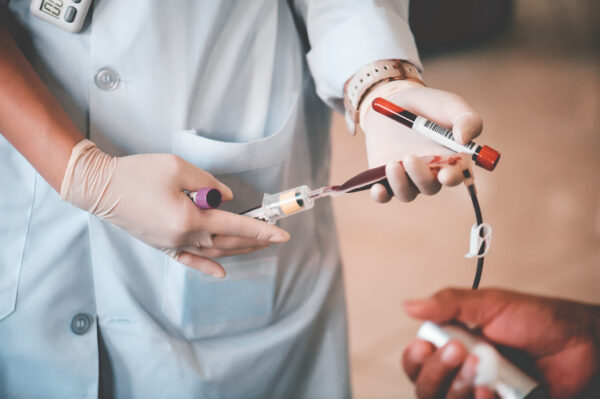
I’ll never forget the patient. I met her in a large academic medical center at 4:15 in the morning. She was in a small room off the emergency department where she had been all night with staff trying to find out what was going on so she could receive the right treatment. She was exhausted and in pain. She said that between IV attempts and blood draws for lab work, she had been stuck with needles 41 times. From the look of her arms, it was clear she was not exaggerating. And now, the phlebotomist I was with was about to stick her for the second time since we’d arrived.
Unfortunately, this type of occurrence can be all too common. Peripheral IV insertion and blood collection are two of the most prevalent inpatient procedures in U.S. hospitals, with up to 90 percent of patients requiring an IV catheter and needing, on average, two blood collections per day. A recent Harris Poll revealed eye-opening data on repetitive needlestick challenges in hospitals. More than half of Americans experienced multiple stick attempts during IV placements and 71 percent during blood draws. In fact, 11 percent of recent hospital patients reported needing ten or more needlesticks for a blood draw.
This survey found that more than 9 in 10 nurses agree that repeat needlesticks negatively impact a patient’s hospital experience. But in addition to a dissatisfying experience for patients and clinicians, these procedures may lead to complications, increased costs and extended hospital stays. They may also amplify the growing problem of venous depletion or the loss of suitable veins for therapies due to damage from existing or past vascular access devices or venipuncture.

Transforming the OR: CEO Reveals Game-Changing AI Tech for Better Efficiency
How Apella leverages technology to increase OR efficiency.
And the challenge is even greater for the nearly two-thirds of adults with difficult intravenous access, where inserting that first IV or getting a blood sample often requires multiple attempts. For patients readmitted at least four times in a year – which is the case for up to a quarter of all hospital inpatients – those patients with difficult intravenous access may receive more than 50 sticks a year.
With this data in mind, my thoughts go back to the ER patient who received more than 40 needlesticks in a matter of hours. There is a better way. We can have an incredible impact for the patient and clinician by advancing these two practices alone. Protecting patients from venous depletion and providing a better care experience requires that we reflect on our attitudes and internalized practices, advocate for change and take steps in favor of evidence-based ways of improving access success.
As a paramedic and a nursing student, we put IV lines in the veins that were easy for us to use – not the best for the patient. We often did not draw labs when putting lines in and the patient would get another needlestick once they got to the hospital. Seeing the prevalence of practices that offered a suboptimal patient experience started me on a journey to improve a patient’s experience and outcomes. I learned how to place IVs away from areas of flexion, like the wrist and elbow, where the risk of complication and replacement is much higher. Phlebotomists helped me learn how to draw blood correctly, so as not to hemolyze specimens, and which tubes were needed. This allowed me to avoid re-drawing the patient. Eventually, I learned how to use technology like near-infrared and ultrasound to improve my chances at first-stick success. And I developed a passion for finding ways to decrease vessel trauma.
However, to achieve a widespread impact that truly helps to raise the standard of care, we must educate and train clinical staff to correctly assess a patient’s vascular health and determine the skills and tools needed to help with success on the first attempt. If a patient reports having difficult intravenous access, rather than attempting multiple placement attempts ourselves, we can call on an experienced team with advanced skills and tools who may be able to place it faster and more efficiently with fewer needlesticks, less wasted time and fewer delays in care.
To help preserve vessel health, we need to make use of innovations designed to minimize vessel trauma from IV insertion, IV replacement and repetitive sticks from blood draws and redraws. These include:
- Ultrasound-guided placement and needle-tracking systems that may help reduce the number of attempts and time to successful vessel access.
- Specialized needle-free blood collection tools designed to use an indwelling peripheral IV catheter for blood collection to minimize venipunctures and help improve the patient experience.
As we adopt and advocate for these new and improved standards of care, we can move away from “the way we’ve always done it,” toward a more compassionate and effective approach by minimizing multiple attempts to place or replace an IV and limiting repetitive needlesticks for blood draws and redraws.
It’s time to change practice for the better – for us as clinicians, for our patients, their families and loved ones.
Photo: kuarmungadd, Getty Images
Jon Bell is a Master’s-Prepared Registered Nurse with more than 25 years of emergency medical experience and 15 years of experience in surgical care. He has combined his backgrounds to specialize in vascular access education and built a successful vascular access specialist team. Jon has experience as a clinical consultant working for multiple companies to support vascular access device training. He has presented at multiple national and regional conferences speaking about vascular access process improvement and research. Jon is currently the Director of the Emergency Department at Mount Desert Island Hospital.
This post appears through the MedCity Influencers program. Anyone can publish their perspective on business and innovation in healthcare on MedCity News through MedCity Influencers. Click here to find out how.









